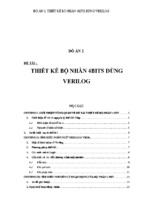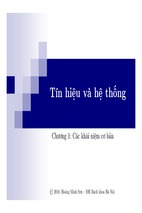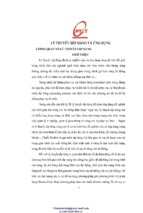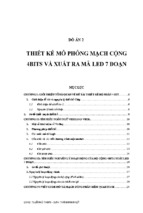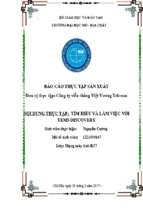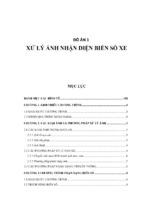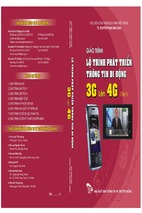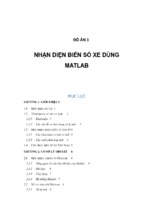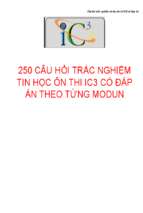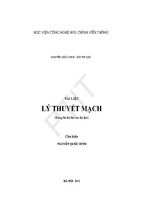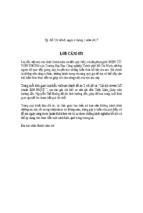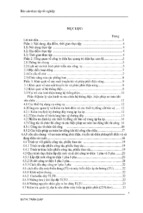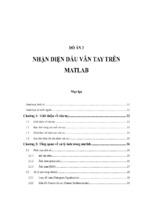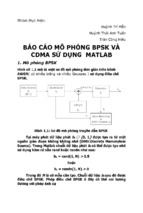Mô tả:
262001
Mobile & Wireless Networking
Lecture 6:
Cellular Systems (UMTS / LTE) (2/2)
& Other systems
[Reader, Part 5]
[Optional: Schiller, Section 4.2, 4.3, 5, 6]
Geert Heijenk
Mobile and Wireless Networking
2009 / 2010
Outline of Lecture 6
Cellular Systems (UMTS / LTE) (2/2)
UMTS High Speed Downlink Packet Access (HSDPA)
UMTS High Speed Uplink Packet Access (HSUPA)
Long Term Evolution
Other systems
IEEE 802.16 WiMAX
DECT
TETRA
Satellite Systems
2
Mobile and Wireless Networking
2009 / 2010
HSDPA (The downlink)
Main improvements:
MAC-layer: from RNC to base station
Improved radio: higher order modulation
initially 16-QAM, newer releases 64 QAM
Techniques used:
Fast Adaptive Modulation & Coding
Fast Channel-Dependent Scheduling
Fast Hybrid ARQ
Result:
increases throughput (→14.4 Mbps)
reduces latency
increases data capacity
newer releases promise throughputs up to 86.4 Mbps
(with MIMO, 64-QAM, and multiple carriers (dual-cell))
Introduction:
2006 (in NL, max 7.2 Mbps)
3
Mobile and Wireless Networking
2009 / 2010
Fast Channel-Dependent Scheduling
Schedule a packet for transmission to a certain user
when it has a “good” channel
• Increases throughput
• May decrease fairness between users
trade-off
4
Mobile and Wireless Networking
2009 / 2010
HSUPA (the enhanced uplink)
Main improvements:
MAC-layer: from RNC to base station (as HSDPA)
no higher order modulation
Techniques used:
Fast Channel-Dependent Scheduling
Fast Hybrid ARQ
Result:
increases throughput (→5.76 Mbps)
reduces latency
increases data capacity
newer releases promise throughputs up to 23 Mbps
(with higher order modulation, and multiple carriers (dual-cell))
Introduction:
2008 (in NL, max 2 Mbps)
5
Mobile and Wireless Networking
2009 / 2010
GSM / UMTS Coverage (2009)
6
Mobile and Wireless Networking
2009 / 2010
Long Term Evolution: Background
•
Evolution of 3G UMTS radio access technology
Supporting (only) (IP) packet-based services
•
Targets:
•
•
•
•
•
•
•
Increased data rates (100 Mbit/s, 50 Mbit/s)
Increased capacity (3 – 4 x Rel. 6 (HSDPA))
Improved spectrum efficiency (x3)
Reduced latency: <10 ms RTT, <100ms channel setup,
Reduced cost
Spectrum flexibility
7
Mobile and Wireless Networking
2009 / 2010
LTE Characteristics
•
Flexible channel bandwidth:
•
•
Duplexing:
•
•
multiple parallel stop-and-wait, with soft combining / incremental
redundancy
Max Data Rates:
•
•
up to 4x4 in downlink, or multi-user MIMO (down-/uplink)
Hybrid ARQ:
•
•
Single Carrier FDMA (OFDMA with extra Discrete Fourier Transform)
MIMO:
•
•
OFDMA
Uplink:
•
•
FDD, TDD, and combined FDD/TDD (half duplex)
Downlink:
•
•
1.4, 3, 5, 10, 15, 20 MHz
75 Mbit/s (uplink), 300 Mbit/s (downlink, with MIMO)
New core network:
•
Evolved Packet Core
8
Mobile and Wireless Networking
2009 / 2010
Duplexing in LTE
9
Mobile and Wireless Networking
2009 / 2010
OFDMA vs SC-FDMA
OFDMA
SC-FDMA
180
15 kHz
10
Mobile and Wireless Networking
2009 / 2010
Evolved Packet Core
11
Mobile and Wireless Networking
2009 / 2010
Outline of Lecture 6
Cellular Systems (UMTS / LTE) (2/2)
UMTS High Speed Downlink Packet Access (HSDPA)
UMTS High Speed Uplink Packet Access (HSUPA)
Long Term Evolution
Other systems
IEEE 802.16 WiMAX
DECT
TETRA
Satellite Systems
12
Mobile and Wireless Networking
2009 / 2010
IEEE 802.16 / WiMAX
WiMAX: Worldwide Interoperability for Microwave Access
Fixed WiMAX
Mobile WiMAX
targeted at fixed wireless
Similar market as UMTS with HSDPA / HSUPA
Standards:
IEEE 802.16-2004: Fixed WiMAX
Based on 2001 standard: a, b, c, and d amendments
IEEE 802.16-2009: Mobile WiMAX
Includes 2005 extensions for mobility, and newer extensions
MAC Modifications for limited mobility:
handover & low power operations
13
Mobile and Wireless Networking
2009 / 2010
WiMAX overview of techniques
Orthogonal Frequency Division Multiple Access (OFDMA)
Flexible (scalable) number of sub-carriers (up to 2048)
Adaptive Modulation
Smart Antenna possible (e.g., MIMO: multiple input, multiple
output)
Fast Scheduling (for both uplink and downlink)
Hybrid ARQ
Fast Channel Feedback
14
Mobile and Wireless Networking
2009 / 2010
WiMAX OFDMA Frame Structure
Source: Mobile WiMAX - Part I: A Technical Overview and Performance Evaluation, WiMAX Forum
A
sub-channel is a group of 48 sub-carriers
Frame duration is 5 ms (symbol time ~ 0.1 ms)
15
Mobile and Wireless Networking
2009 / 2010
Outline of Lecture 6
Cellular Systems (UMTS / LTE) (2/2)
UMTS High Speed Downlink Packet Access (HSDPA)
UMTS High Speed Uplink Packet Access (HSUPA)
Long Term Evolution
Other systems
IEEE 802.16 WiMAX
DECT
TETRA
Satellite Systems
16
Mobile and Wireless Networking
2009 / 2010
Digital Enhanced Cordless Telecommunication (DECT)
DECT (Digital European Cordless Telephone) standardized by
ETSI for cordless telephones, renamed for international
marketing reasons into „Digital Enhanced Cordless
Telecommunication“
standard describes air interface between base-station and
mobile phone
Characteristics
frequency: 1880-1990 MHz
channels: 120 full duplex
duplex mechanism: TDD (Time Division Duplex) with 10 ms frame
length
multiplexing scheme: FDMA with 10 carrier frequencies,
TDMA with 2x 12 slots
modulation: digital, Gaußian Minimum Shift Key (GMSK)
power: 10 mW average (max. 250 mW)
range: approx. 50 m in buildings, 300 m open space
17
Mobile and Wireless Networking
2009 / 2010
DECT Dynamic Channel Allocation
periodically (< 30s) measure RSSI on all frequency/timeslot
combinations
keep list of combinations with least RSSI for setting up new
channels
listen to channels with high RSSI to see what is strongest basestation
18
Mobile and Wireless Networking
2009 / 2010
Outline of Lecture 6
Cellular Systems (UMTS / LTE) (2/2)
UMTS High Speed Downlink Packet Access (HSDPA)
UMTS High Speed Uplink Packet Access (HSUPA)
Long Term Evolution
Other systems
IEEE 802.16 WiMAX
DECT
TETRA
Satellite Systems
19
Mobile and Wireless Networking
2009 / 2010
Trunked Radio Systems
many different radio carriers
assign single carrier for a short period to one user/group of
users
police, ambulance, rescue teams, taxi service, fleet
management
interfaces to public networks, voice and data services
very reliable, fast call setup, local operation
20
Mobile and Wireless Networking
2009 / 2010
- Xem thêm -

